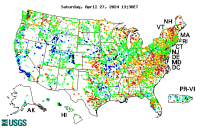USGS Surface Water Information
New & Noteworthy
Today's Water ConditionsView maps of current and historical conditions 
USGS in Your StateUSGS Water Science Centers are located in each state. ![[Map: There is a USGS Water Science Center office in each State.]](http://www.usgs.gov/frameworkfiles/includes/imagemaps/usmapsmall.gif)
Other Water SitesPDF Reader!Documents are presented in Portable Document Format (PDF); the latest version of Adobe Reader or similar software is required to view it. Download the latest version of Adobe Reader, free of charge. |
Global Change Hydrology Program (Hydroclimatology)Please contact Julie Kiang with questions.
OverviewThe Global Change Hydrology Program was begun in 1990 to develop data, understanding, and predictive capabilities related to water and associated aspects of carbon and the greenhouse gases as they interact with global systems. The Program is part of the USGS Global Change Research Program (Geochange) which, in turn, is an element of the U.S. Global Change Research Program (USGCRP). Global Change Hydrology has two broad components: 1) investigations of hydroclimatic variability, and 2) studies of the biogeochemistry of greenhouse gases. The former are coordinated by the Office of Surface Water and are described herein. The latter are coordinated by the Office of Hydrologic Research, and additional information on those can be obtained at NRP, at WEBB, and at carbon cycle. Both components are national in scope and maintain strong programmatic linkages to scientists and projects supported by NSF, NOAA, and NASA. The hydroclimatic research components of the Program focus on characterizing, and developing predictive methods related to, the hydroclimatology of North America. This includes identification of seasonal variations in regional streamflow in relation to atmospheric circulation (for regional streamflow prediction and flood/drought hazard assessment); the linkage between atmospheric circulation and snowpack accumulation (for forecasting spring and summer water supply in the western United States and for flood forecasting) as well as glacier mass balance; and the physical and chemical variability in riverine and estuarine environments in relation to large-scale atmospheric and oceanic conditions(to discriminate natural from human-induced effects on such systems). It also includes documenting the long-term behavior of hydrologic systems in response to past climatic variations and changes (from decades to hundreds of thousands of years) as well as more recent (decadal) hydrologic trends. Finally, the Program maintains an active effort to develop improved representations of terrestrial hydrologic processes in general circulation and regional climate models. In broad terms, these activities are aimed at improving statistical and deterministic methods for predicting hydrologic hazards and related environmental conditions on monthly to interannual time scales. Harry LinsOffice of Surface Water, USGS Research Activities
Data SetsHCDN Hydro-Climatic Data NetworkGREDS GEWEX Continental-scale International Project Reference Data Set Benchmark Glacier Data Devils Hole Core DH-11 Fact SheetsOFR 93-642 DroughtFS-062-95 Northern California Storms and Floods of January 1995 SF-Bay Seasonal/Yearly Salinity Variations in San Francisco Bay Devils Hole Primer Links to Other USGS Global Change Sites
PublicationsSelected Publications of the Global Change Hydrology (Hydroclimatology) Program, 1988 - 1997Selected Publications of the Global Change Hydrology (Hydroclimatology) Program, 1998-Present BibliographyWater and Climate Bibliography (Pacific Institute)
|